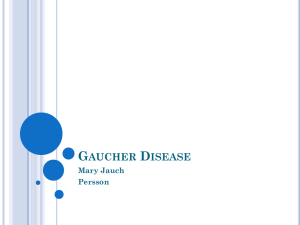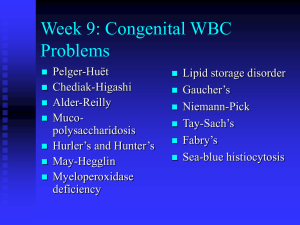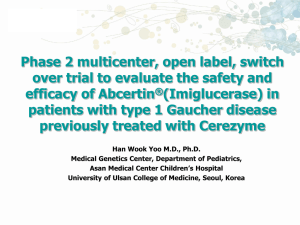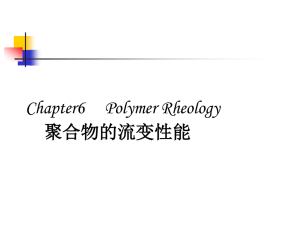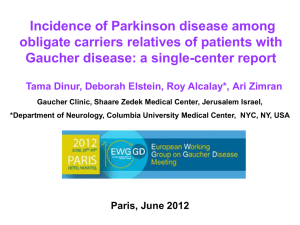Blood Rheology in Gaucher Disease
advertisement
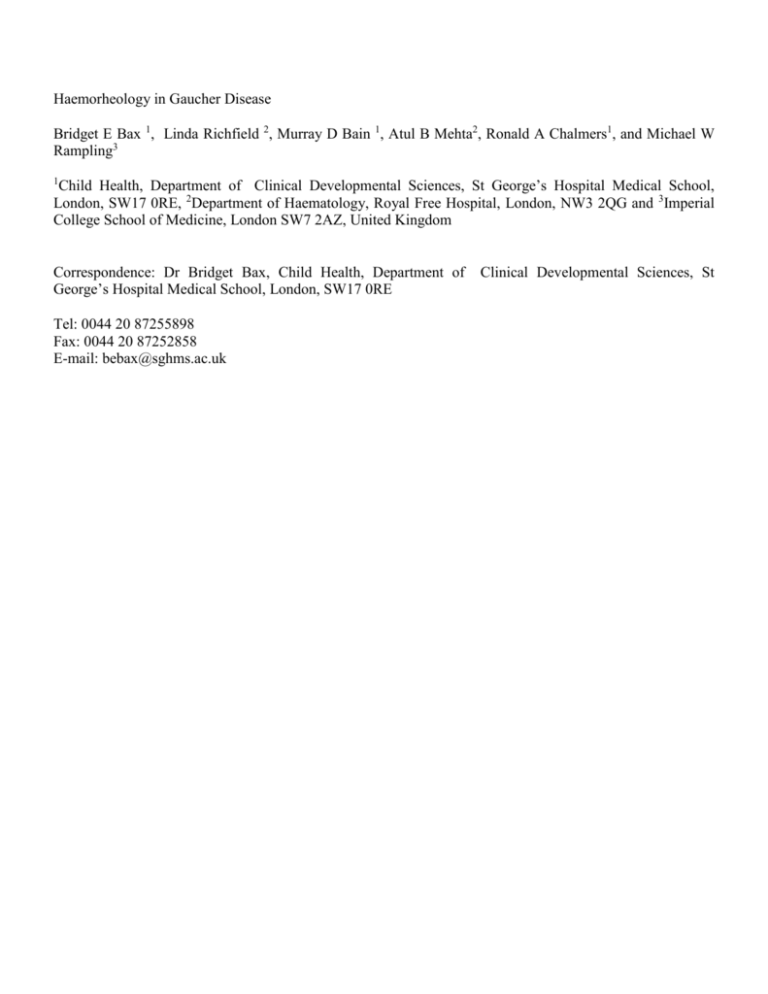
Haemorheology in Gaucher Disease Bridget E Bax 1, Linda Richfield 2, Murray D Bain 1, Atul B Mehta2, Ronald A Chalmers1, and Michael W Rampling3 Child Health, Department of Clinical Developmental Sciences, St George’s Hospital Medical School, London, SW17 0RE, 2Department of Haematology, Royal Free Hospital, London, NW3 2QG and 3Imperial College School of Medicine, London SW7 2AZ, United Kingdom 1 Correspondence: Dr Bridget Bax, Child Health, Department of George’s Hospital Medical School, London, SW17 0RE Tel: 0044 20 87255898 Fax: 0044 20 87252858 E-mail: bebax@sghms.ac.uk Clinical Developmental Sciences, St Abstract In Gaucher disease a deficiency of glucocerebrosidase results in the accumulation of glucocerebroside within the lysosomes of the monocyte-macrophage system. Prior to the availability of enzyme replacement therapy (ERT), splenectomy was often indicated for hypersplenism. Haemorheological abnormalities could be expected in view of the anaemia and abnormal lipid metabolism in these patients and the role of the spleen in controlling erythrocyte quality. Objectives: To investigate the effect of Gaucher disease on blood and plasma viscosity, erythrocyte aggregation and erythrocyte deformability, and to determine whether observed rheological differences could be attributed to splenectomy. Methods: Haematological and haemorheological measurements were made on blood collected from 26 spleen-intact patients with Gaucher disease, 16 splenectomised patients with Gaucher disease, 6 otherwise healthy asplenic non-Gaucher disease subjects, and 15 healthy controls. Results: No haemorheological differences could be demonstrated between spleenintact patients with Gaucher disease and the control group. Compared to controls, both asplenic Gaucher disease and asplenic non-Gaucher disease study groups had a reduced MCHC (p = 0.003 and 0.005, respectively) and increased whole blood viscosity at 45% haematocrit, relative viscosity and red cell aggregation index – all measured at low shear (p<0.05 for all). Additionally, asplenic patients with Gaucher disease alone showed an increased MCV (p = 0.006), an increased whole blood viscosity at 45% haematocrit measured at high shear (p = 0.019), and a reduced relative filtration rate (p = 0.0001), compared to controls. Conclusion: These observations demonstrate a direct and measurable haemorheological abnormality in Gaucher disease only revealed when there is no functioning spleen to control erythrocyte quality. Keywords Gaucher disease, spleen, erythrocytes, whole blood viscosity, plasma viscosity, hemorheology, erythrocyte deformability, erythrocyte aggregability Introduction Gaucher disease is an autosomal recessive disorder caused by a deficiency of the lysosomal hydrolase, glucocerebrosidase. This enzyme is responsible for the degradation of the glycolipid, β-glucocerebroside, produced from the turnover of senescent red and white blood cell membranes. Glucocerebroside accumulates within the lysosomes of the monocyte-macrophage system to produce the characteristic lipid-laden Gaucher cells. The displacement of healthy cells by Gaucher cells in the bone marrow, spleen and liver is thought to underlie the visceral and skeletal manifestations in patients with Gaucher disease, such as hepatosplenomegaly, organ dysfunction, anaemia, bone disease. Gaucher disease types 2 and 3 are characterised by neurological involvement in addition to type 1 symptoms. Prior to the availability of ERT which effectively improves the multi-system involvement, splenectomy was often indicated in cases with severe anaemia, functional hypersplenism or when the spleen size caused discomfort or became infarcted. In view of the abnormal haematology and lipid metabolism in these patients, and the role of the spleen in maintaining the rheological properties of blood (1), abnormalities in the haemorheology of these patients may be expected. Alterations in rheological variables influencing the flow of blood at both the macro and microcirculatory level have previously been shown to contribute to clinical pathology in other disorders (24). We therefore investigated the effect of Gaucher disease on blood and plasma viscosity, erythrocyte aggregation and erythrocyte deformability to determine whether observed rheological differences might be modulated through splenic function, or as a direct effect of the disease process itself. We compared haematological and haemorheological parameters of healthy control subjects with four subject groups; spleen intact patients with Gaucher disease receiving ERT, spleen intact patients with Gaucher disease not receiving ERT, asplenic patients with Gaucher disease and otherwise healthy asplenic non-Gaucher disease subjects. Subjects and methods Fifteen healthy control subjects, and four study groups were recruited. The latter groups were 21 patients with Gaucher disease with intact spleens receiving ERT, 5 patients with Gaucher disease with intact spleens not on ERT, 16 asplenic patients with Gaucher disease receiving ERT and 6 asymptomatic asplenic nonGaucher subjects. Of the intact spleen group, 20 patients were receiving imiglucerase infusions, 9 of which were receiving a median weekly dose of 800IU (range 400 to 1200IU) and 11, a median fortnightly dose of 800IU (range 400 to 2400). One patient was receiving weekly infusions of 400IU alglucerase. All asplenic patients with Gaucher disease were receiving ERT with imiglucerase, 8 receiving a median weekly dose of 700IU (range 400 to 800) and 8 receiving a median fortnightly dose of 1200 IU (range 400 to 2000). The mean length of time the patients had been receiving ERT were 5.1 0.6 years and 5.4 0.7 years, respectively, for spleen intact and asplenic patients. In all cases, splenectomy was performed prior to receiving ERT. All patients receiving ERT had haematological parameters within laboratory reference range. Healthy controls were identified through Departmental contacts, and patients with Gaucher disease and asplenic non-Gaucher subjects were recruited through the Lysosomal Storage Disorders Clinic and the Haematology clinic of the Royal Free Hospital, respectively. The indication for splenectomy in all asymptomatic non-Gaucher subjects was idiopathic thrombocytopenic purpura. Cigarette smokers were excluded from this study because of the association of smoking with decreased cell deformability and reduced blood and plasma viscosities (5-8). Ten millilitres of venous blood were collected after informed consent into lithium heparinised tubes (10 IU heparin/ml blood) and analysed within 4 hours of collection. This study was approved by the Research Ethics Committees at The Royal Free and St. George’s Hospitals. Informed consent was given by all participants. Measurement of haematological parameters Percentage haematocrit (Hct) was determined in whole blood and haematocrit corrected blood using a microhaematocrit centrifuge (Hawksley, West Sussex) and a microhaematocrit reading device. Cell number, haemoglobin concentration (Hb), mean cell volume (MCV), mean corpuscular haemoglobin (MCH) and mean corpuscular haemoglobin concentration (MCHC) were determined using an AcT Coulter counter. Plasma fibrinogen was measured in citrated plasma by the Clinical Chemistry Department, St. George’s Hospital using an automated assay. Serum concentrations of LDL cholesterol, HDL cholesterol and triglycerides were measured in spleen-intact patients with Gaucher disease receiving ERT and asplenic patients with Gaucher disease by the Clinical Chemistry Department, Royal Free Hospital. Viscosity measurements Viscosity measurements were performed at 37oC using a Contraves Low Shear 30 rotational viscometer fitted with a bob-in-cup system (Contraves AG, Zurich, Switzerland), according to the recommendations of the International Committee for Standardization in Haematology [9]. Native whole blood viscosity was measured at both low (0.277s-1) and high (128.5s-1) shear rates. Due to the sensitivity of blood viscosity to haematocrit, blood was corrected to a standard haematocrit of 45% by the addition or subtraction of autologous plasma, and the viscosities re-measured at both low and high shear rates (corrected blood viscosity). Plasma viscosity can be affected by the concentration of plasma constituents, and therefore to assess the contribution of plasma to the viscosity of whole blood, plasma viscosity was measured. Plasma has Newtonian properties and viscosity was thus determined at high shear rates only; shear rates of 69.5, 94.5 and 128.5s-1were used and the three readings averaged. Relative blood viscosity (the ratio of corrected blood viscosity/plasma viscosity) was calculated for both low and high shear rates as indirect measures of erythrocyte aggregation and deformability, respectively. Determination of erythrocyte aggregation Erythrocyte aggregation indices were also obtained using a Myrenne Erythrocyte Aggregometer, (Myrenne GmbH, Roetgen, Germany), a technique based on the increased transmission of light through gaps in a suspending medium when erythrocytes aggregate. Twenty-five microlitres blood corrected to a haematocrit of 45% were placed between a transparent cone and plate device and subjected to a high shear rate to disaggregate the cells. After a short delay, either in stasis (M aggregation index), or at a low shear rate of 3s-1 (M1 aggregation index) a digital readout was obtained reflecting erythrocyte aggregation in the absence of shear and erythrocyte aggregation in the presence of fluid movement, respectively. These measurements were made at 22oC and the final aggregation indexes represent the mean of three readings. Determination of erythrocyte deformability Erythrocyte deformability was assessed according the Guidelines of the International Committee for Standardization in Haematology (9). Blood was centrifuged at 3,000 g for 10 minutes and the plasma, buffy coat and upper 10% of the packed cells discarded. The leukocyte-depleted cell suspension was washed twice in filtered phosphate buffered saline (PBS), pH 7.4, with centrifugation at 3,000g for 10 minutes and then suspended in filtered PBS to a final haematocrit of 10%. The rate of erythrocyte filtration through Nuclepore polycarbonate membranes with pore diameters of 5 µm (Whatman, United Kingdom) was measured at 22oC, using the St. George’s Blood Cell Filtrometer (10). Membranes from the same batch were used throughout this study to avoid variations in the distribution and geometry of pores. For each sample, three measures of filtration rate were made at a pressure of 4cm water; the first value was obtained after filtration of 20µl and the three filtration rates calculated as subsequent 20µl were filtered as a continuous flow. By extrapolation, the initial filtration rate is determined, thereby eliminating the effect of filter clogging. Results are expressed as a ratio of the initial erythrocyte filtration rate to that of the suspending medium (PBS). Statistics Results are expressed as mean ± SEM and unless otherwise stated, significant differences between groups were assessed using a one way analysis of variance (ANOVA) test, followed by Gabriel’s post hoc multiple comparison for unequal sized groups to differentiate which groups were significantly different. Groups compared were control vs spleen intact Gaucher patients receiving ERT vs spleen intact Gaucher patients not receiving ERT, and control vs asplenic Gaucher patients vs asplenic non-Gaucher patients. Differences were considered significant when p<0.05. Results Table 1 summarises the haematological parameters and ages for the control group and four study groups. The mean (± SEM) age of the study groups did not differ significantly from the control group. Haemoglobin concentrations were significantly lower in spleen-intact patients with Gaucher disease not receiving ERT and asplenic patients with Gaucher disease, compared to the control group, (p = 0.02 and 0.003, respectively). However, only in the spleen intact Gaucher disease study group not receiving ERT were the haemoglobin concentrations below the laboratory reference range. ANOVA showed a significant difference in the haematocrit between the control and spleen intact Gaucher ERT groups; post hoc analysis using Gabriel’s test showed this difference was due to a significantly lower haematocrit in both the spleen-intact patients with Gaucher disease receiving ERT (though within the laboratory reference range) and spleen intact patients with Gaucher disease not receiving ERT, compared to the control group (p =0.027 and p =0.001, respectively). Haematocrit was not influenced by the sex of the patient; haematocrit of 41 ± 2 and 37 ± 1, respectively for male and female patients receiving ERT (p =0.08, Student’s two-sample t-test), and haematocrit of 30 ± 3 and 38 ± 1, respectively for male and female patients not receiving ERT, (p =0.20, Student’s two sample t-test). Significant differences in the MCHC and MCV were observed between the control, asplenic Gaucher disease and asplenic non-Gaucher disease groups; further analysis with Gabriel’s test showed that these differences were due to a reduced MCHC in both asplenic Gaucher (p =0.003) and asplenic non-Gaucher study groups (p =0.005), and an increase in the MCV in the asplenic Gaucher disease group (p =0.006), compared to the control group. Serum lipid concentrations (mmol/l) for in spleen-intact patients with Gaucher disease receiving ERT and asplenic patients with Gaucher disease were: HDL cholesterol, 1.28 0.08 and 1.15 0.16; LDL cholesterol, 2.38 0.18 and 2.18 0.30; triglycerides, 1.39 0.16 and 1.66 0.41. There were no significant differences between the lipid concentrations in the two groups of patients and the values were all within the laboratory reference range. Table 2 shows the haemorheological parameters for the control group and four study groups. Compared to the control group, asplenic patients with Gaucher disease and asplenic non-Gaucher subjects had significantly higher whole blood viscosities at 45% haematocrit, measured at low shear (p = 0.01 and 0.044, respectively), higher relative viscosities at low shear (p = 0.028 and 0.037, respectively) and increased red cell aggregation indexes at low shear (p= 0.027 and 0.033, respectively). Additional significant differences found between the asplenic Gaucher disease study group and the control group were whole blood viscosity at 45% haematocrit, measured at high shear (p = 0.019), and relative red cell filtration rate (p =0.0001) which were higher and lower, respectively in the patient group. Discussion The success of ERT in treating the visceral manifestations of Gaucher disease has revealed a differential responsiveness to therapy in other organ systems such as brain, bone and lungs that is indicative of differing pathological processes occurring in this multi-system disease. In this study we investigated the haematological and haemorheological properties of blood taken from patients with Gaucher disease to investigate the haemorheological abnormalities that might be found, and how they might be influenced by splenic function. Both asplenic patients with Gaucher disease and asplenic non-Gaucher subjects demonstrated a significant increase in whole blood viscosity at 45% haematocrit, relative viscosity (ratio of whole blood viscosity at 45% haematocrit to plasma viscosity) and red cell aggregation index at low shear rates. The erythrocytes of both asplenic patients with Gaucher disease and asplenic non-Gaucher subjects are therefore more aggregable than those of controls, indicating that these differences are due to the effects of splenectomy. Erythrocyte aggregation is determined by plasma protein and lipid concentration, and erythrocyte surface properties (2, 11, 12). Plasma fibrinogen concentration (Table 1) and plasma viscosity were not significantly different in both asplenic study groups from the control group, and in the asplenic Gaucher disease group, lipid concentrations were within the laboratory reference range, indicating that the increased erythrocyte aggregation is due to an alteration in the erythrocyte membrane. These findings agree with those of Robertson et al. (13) who also observed no differences in plasma viscosity or fibrinogen concentration in patients who had undergone splenectomy, compared to controls matched for age, sex and tobacco consumption. Zimran et al have recently reported a significantly elevated concentration of fibrinogen in patients with Gaucher disease which was accompanied by an enhanced erythrocyte adhesiveness and aggregation, compared to matched, healthy controls (14). It should be noted, however, that the fibrinogen concentrations in these patients were within the laboratory reference range and that no information was provided on the spleen or ERT status of these patients. N-acetyl neuraminic acid, the principal determinant of the erythrocyte’s negative surface charge, decreases with increasing cell age, and studies have shown that this decrease is associated with a reduced surface charge density and an increase in erythrocyte aggregation (15). Since the spleen removes senescent erythrocytes from the circulation, its absence could be expected to result in the continued circulation of aged erythrocytes with diminished N-acetyl neuraminic acid content, and this may explain the increased erythrocyte aggregation observed in the asplenic study groups. Asplenic patients with Gaucher disease, but not asplenic non-Gaucher subjects, demonstrated a significant increase in whole blood viscosity at high shear and a significant decrease in the red cell filtration rate compared to the control subjects; red cell deformability is therefore reduced in asplenic patients with Gaucher disease but not asplenic non-Gaucher subjects. Erythrocyte deformability is determined by cell geometry (volume, surface area and shape), cytoplasmic viscosity (MCHC), membrane viscoelasticity and the metabolic status of the cell. While MCHC was significantly decreased in the asplenic Gaucher disease group, it was similarly decreased in the asplenic non-Gaucher disease group. A significant increase in MCV was found in asplenic Gaucher patients alone, compared to the control group. These alterations indicate that changes in cell geometry and cytoplasmic viscosity may be contributing to the reduced erythrocyte deformability. As these altered parameters were not accompanied by an increase in the cellular content of haemoglobin (MCH), this indicates that the increased cell volume is due either to an increased concentration of an osmotically active substance, other than haemoglobin, or an altered permeability of the cell membrane resulting in a raised influx of water. The erythrocytes of splenectomised individuals have an increased number of Howell-Jolly bodies (nuclear fragments) and Heinz bodies (focal precipitates of denatured haemoglobin) therefore demonstrating the role of the spleen in facilitating the removal of these structures. Studies of Reinhart et al., have shown that when the entire erythrocyte membrane is coated with artificially induced Heinz bodies, erythrocyte filterability and membrane deformability are drastically reduced (16). The red cell membrane of patients with Gaucher disease has a 2 to 3 fold increase in glucocerebroside content (17, 18), and thus there is the possibility that these factors are contributing to the reduced deformability of the cell membrane of asplenic patients with Gaucher disease. There are no reported studies correlating imiglucerase therapy or its predecessor, the human placenta-derived alglucerase, with a reduction in erythrocyte membrane glucocerebroside content, although reductions in intracellular levels of glucocerebroside content are well documented. Our studies indicate that ERT is not altering red cell deformability. This interpretation has a precedent in the studies on erythrocytes from diabetic patients which have postulated an association between an altered erythrocyte membrane lipid composition and decreased red cell deformability (19, 20). Substrate reduction therapy with miglustat, an inhibitor of glycosphinolipid biosynthesis, has recently been licensed to treat patients with type 1 Gaucher disease (21); the effect of this treatment on the composition of the red cell membrane and on red cell deformability deserves further study. It is interesting to note that Lachmann et al. have demonstrated that miglustat treatment normalises lipid trafficking in peripheral blood B lymphocytes of a patient with Niemann-Pick disease type C (22). Our study indicates a significant effect of splenectomy on the rheology of red cells of patients with Gaucher disease. Not only does the spleen have a role in controlling the quality of erythrocytes in the circulatory system by removing erythrocyte intracytoplasmic inclusions and excess surface membrane, but we have shown that in Gaucher disease there is an adverse effect on membrane deformability. This could be through an abnormal membrane lipid composition, reducing membrane deformability leading to an obstruction of the microcirculation by rigid erythrocytes, resulting in an impaired blood flow, decreased local oxygen tensions and ultimately tissue death. This would be supported by studies showing that splenectomised patients with Gaucher disease have a higher incidence of osteonecrosis (23). Alternatively, we could not exclude it being an effect of ERT, only revealed in the absence of the spleen. This would be supported by the study by Schiffmann et al, demonstrating that splenectomised patients receiving ERT showed a progressive reduction in bone mineral density (24). A patient cohort of asplenic patients with Gaucher disease, not receiving ERT would distinguish between these two possibilities. Of particular interest is the bone disease in Gaucher disease, which is thought be due to the replacement of the bone marrow and trabecular bone with infiltrates of Gaucher cells. In contrast to the other manifestations of the disease, the bone pathology responds more slowly to ERT and this is not fully understood, especially as there is apparently significant uptake of enzyme by the bone marrow at sites of skeletal disease (25, 26). There are similarities between the bone disease in Gaucher disease and sickle cell disease, a condition in which the pathology is a result of severe abnormalities in red cell rheology (27, 28). In conclusion, this study demonstrates a significant increase in erythrocyte aggregation in both asplenic Gaucher and asplenic non-Gaucher study groups. Significant differences confined to asplenic patients with Gaucher disease were found; the erythrocytes of these patients were larger and less deformable than those of the controls. In contrast to other Gaucher-related pathologies, enzyme replacement appears not to reverse the haematological differences observed in the asplenic Gaucher disease group. These results suggest that while Gaucher disease affects the physical properties of the erythrocyte, haemorheological homeostasis is maintained by the presence of a spleen. The role of the red cell membrane may be more important in the pathogenesis of Gaucher disease than hitherto recognised. Acknowledgment The authors wish to express their appreciation to the participants who kindly donated blood for this study. References 1. BAŞKURT OK. The role of the spleen in suppressing the rheological alterations in circulating blood. Clin Hemorheol Microcirc 1999; 20: 181-188. 2. RAMPLING MW. Red cell aggregation and yield stress. In: Lowe GDO, ed. Clinical Blood Rheology. Boca Raton: CRC Press, 1988: 45-64. 3. RAMPLING MW. Effect of blood rheology on cardiac output. In: Salmasi AM, Iskandrian AS, eds. Cardiac Output and Regional Flow in Health and Disease. Netherlands: Kluwer Academic publishers, 1993:107-124. 4. BAŞKURT OK. Pathophysiological significance of blood rheology. Turk J Med Sci 2003; 33: 347-355. 5. NORTON JM, RAND PW. Decreased deformability of erythrocytes from smokers. Blood 1981; 7: 671674. 6. RAMPLING MW, BROWN JR, ROBINSON RJ, FEHER MD, CHOLERTON S, SEVER PS. The shortterm effects of abstention from tobacco by cigarette smokers on blood viscosity and related parameters. Clin Hemorheol 1991; 11: 441-446. 7. ERNST E. Haemorheological consequences of chronic cigarette smoking. J Cardiovasc Risk 1995; 2: 435-439. 8. HAUSTEIN KO, KRAUSE J, HAUSTEIN H, RASMUSSEN T, CORT N. Effects of cigarette smoking or nicotine replacement on cardiovascular risk factors and parameters of haemorheology. J Inter Med 2002; 252: 130-139. 9. INTERNATIONAL COMMITTEE FOR STANDARDIZATION IN HAEMATOLOGY. Guidelines for measurement of blood viscosity and erythrocyte deformability. Clin Hemorheol 1986; 6: 439-453. 10. DORMANDY J, FLUTE P, MATRAI A, BOGAR L, MIKITA J, LOWE GDO, ANDERSON J, CHIEN S, SCHMALZER E, HERSCHENFELD A. The New St George’s Blood Filtrometer. Clin Hemorheol 1985; 5: 975-983. 11. CHIEN S, SUNG LA. Physicochemical basis and clinical implications of red cell aggregation. Clin Hemorheol 1987; 7: 71-91. 12. RAMPLING MW, MEISELMAN HJ, NEU B, BASKURT OK. Influence of cell-specific factors on red blood cell aggregation. Biorheology 2004; 41: 91-112. 13. ROBERTSON, D.A.F., SIMPSON, F.G. & LOSOWSKY, M.S. Blood viscosity after splenectomy. Br Med J 1981; 283: 573-575. 14. ZIMRAN A, BASHKIN A, ELSTEIN D, RUDENSKY B, ROTSTEIN R, ROZENBLAT M, MARDI T, ZELTSER D, DEUTSCH V, SHAPIRA I, BERLINER S. Rheological determinants in patients with Gaucher disease and internal inflammation. Am J Hematol 2004; 75:190-194. 15. HADENGUE AL, DEL-PINO M, SIMON A, LEVENSON J. Erythrocyte disaggregation shear stress, sialic acid, and cell aging in humans. Hypertension 1998; 32: 324-330. 16. REINHART WH, SUNG LP, CHIEN S. Quantitative relationship between Heinz body formation and red blood cell deformability. Blood 1986; 68:1376-83. 17. BRADY RO, PENTCHEV PG, GAL AE, HIBBERT SR, DEKABAN AS. Replacement therapy for inherited enzyme deficiency: use of purified glucocerebrosidase in Gaucher’s disease. N Engl J Med 1974; 291: 989-993. 18. NILSSON O, HKANSSON G, DREDORG S, GROTH CG, SVENNERHOLM L. Increased cerebroside concentration in plasma and erythrocytes in Gaucher disease: significant differences between Type I and Type III. Clin Genet 1982; 22: 274-279. 19. GARNIER M, ATTALI JR, VALENSI P, DELATOUR-HANSS E, GAUDEY F, KOUTSOURIS D. Erythrocyte deformability in diabetes and erythrocyte membrane lipid composition. Metabolism 1990; 39:794-798. 20. PERSSON SU, WOHLFART G, LARSSON H, GUSTAFSON A. Correlations between fatty acid composition of the erythrocyte membrane and blood rheology data. Scand J Clin Lab Invest 1996; 56: 183190. 21. COX T, LACHMANN R, HOLLAK C, AERTS J, VAN WEELY S, HREBICEK M, PLATT F, BUTTERS T, DWEK R, MOYSES C, GOW I, ELSTEIN D, ZIMRAN A. A novel oral treatment of Gaucher's disease with N-butyldeoxynojirimycin (OGT 918) to decrease substrate biosynthesis. Lancet 2000; 355: 1481 – 1485. 22. LACHMANN RH, TE VRUCHTE D, LLOYD-EVANS E, REINKENSMEIER G, SILLENCE DJ, FERNANDEZ-GUILLEN L, DWEK RA, BUTTERS TD, COX, TM, PLATT, FM. Treatment with miglustat reverses the lipid trafficking defect in Niemann-Pick disease Type C. Neurobiol Disease 2004; 16: 654-658. 23. RODRIGUE SW, ROSENTHAL DI, BARTON NW, ZURAKOWSKI D, MANKIN HJ. Risk factors for osteonecrosis in patients with type 1 Gaucher’s disease. Clin Orthop 1999; 362: 201-207. 24. SCHIFFMANN R, MANKIN H, DAMBROSIA JM, XAVIER RJ, KREPS C, HILL SC, BARTON NW, ROSENTHAL DI. Decreased bone density in splenectomized Gaucher patients receiving enzyme replacement therapy. Blood Cells Mol Dis. 2002; 28:288-296. 25. BARTON NW, BRADY RO, DAMBROSIA JM, BISCEGLIE AM, DOPPELT SH, HILL SC, MANKIN HJ, MURRAY GJ, PARKER RI, ARGOFF CE, GREWAL RP, YU K-T. Replacement therapy for inherited enzyme deficiency - macrophage targeted glucocerebrosidase for Gaucher’s disease. N Engl J Med 1991; 324:1464-1470. 26. MISTRY PK, WRAIGHT EP, COX TM. Therapeutic delivery of proteins to macrophages: implications for treatment of Gaucher’s disease. Lancet 1996; 348: 1555-1559. 27. AKINOLA NO, STEVENS SME, FRANKLIN IM, NASH GB, STUART J. Rheological changes in the prodromal and established phases of sickle cell vaso-occlusive crisis. Br J Haematol 1992; 81:598-602. 28. BALLAS SK, SMITH ED. Red blood changes during the evolution of the sickle cell painful crisis. Blood 1992; 79:2154-2163. Table 1. Haematological parameters and ages for control and study groups Control Spleen-intact Gaucher pa Asplenic Gaucher Asplenic non-Gaucher 8, 8 4, 2 pb +ERT -ERT N (male, female) 9, 6 10, 11 3, 2 Age 40.8 ± 2.5 47.1 ± 3.7 54.4 ± 14.4 ns 43.6 ± 3.0 49.7 ± 6.3 ns Hb (g/dl) 14.3 ± 0.3 12.9 ± 0.5 10.6 ± 0.9* 0.003 12.8 ± 0.3* 13.8 ± 0.3 0.003 Hct (%) 44 ± 1 39 ± 1* 33 ± 2* 0.001 41 ± 1 44 ± 1 ns MCV (fl 92.9 ± 1.1 92.7 ± 1.6 95.5 ± 5.0 ns 97.8 ± 1.0* 93.1 ± 1.9 0.005 MCH (pg) 30.6 ± 0.4 30.5 ± 0.6 30.3 ± 1.9 ns 31.3 ± 0.4 29.5 ± 1.0 ns MCHC (g/dl) 33.0 ± 0.2 33.0 ± 0.3 31.7 ± 0.9 ns 32.1 ± 0.2* 31.8 ± 0.3* 0.001 Fibrinogen (g/l) 2.8 ± 0.2 2.4 ± 0.2 2.7 ± 0.1 ns 2.7 ± 0.3 2.6 ± 0.3 ns a Level of statistical significance using one-way ANOVA to compare Control vs Spleen intact Gaucher +ERT vs Spleen intact Gaucher –ERT b Level of statistical significance using one-way ANOVA to compare Control vs Asplenic Gaucher vs Asplenic non Gaucher * Statistically different from control using Gabriel’s multiple comparison test for unequal sized groups ns not significant using one-way ANOVA Table 2. Haemorheological parameters for control and study groups Spleen-intact Gaucher +ERT -ERT (n = 21) (n = 5) pa Asplenic Gaucher (n = 16) Asplenic non-Gaucher (n = 6) pb Whole blood viscosity, native hct: low shear (mPa s) 45.86 ± 2.84 high shear mPa s) 4.00 ± 0.15 38.32 ± 4.05 3.92 ± 0.20 39.84 ± 8.51 3.38 ± 0.32 ns ns 49.21 ± 4.51 4.59 ± 0.16 56.68 ± 4.45 4.47 ± 0.19 ns ns Whole blood viscosity, 45% hct: low shear (mPa. s) 49.21 ± 2.06 high shear (mPa. s) 4.13 ± 0.13 52.29 ± 2.40 4.41 ± 0.11 57.48 ± 6.52 4.57 ± 0.14 ns ns 58.77 ± 2.51* 4.59 ± 0.16* 59.39 ± 3.34* 4.39 ± 0.09 0.006 0.022 Plasma viscosity (mPa. s) 1.41 ± 0.03 1.40 ± 0.02 1.38 ± 0.03 ns 1.49 ± 0.04 1.48 ± 0.05 ns Relative viscosity: low shear high shear 34.93 ± 1.09 2.96 ± 0.12 37.42 ± 1.69 3.09 ± 0.11 42.04 ± 5.45 3.31 ± 0.03 ns ns 39.28 ± 1.77* 3.09 ± 0.10 40.38 ± 2.50* 2.99 ± 0.11 0.011 ns Red cell aggregation index: M, stasis M1, shear 3 s-1 3.3 ± 0.3 10.3 ± 0.5 4.0 ± 0.4 11.9 ± 0.5 3.6 ± 0.6 11.2 ± 1.1 ns ns 2.5 ± 0.2 11.7 ± 0.3* 3.0 ± 0.2 12.1 ± 0.1* ns 0.011 Red cell filtration rate 0 .65 ± 0.006 0.65 ± 0.006 0.67 ± 0.017 ns 0.58± 0.011* 0.65 ± 0.026 0.001 Control (n = 15) a Level of statistical significance using one-way ANOVA to compare Control vs Spleen intact Gaucher +ERT vs Spleen intact Gaucher –ERT b Level of statistical significance using one-way ANOVA to compare Control vs Asplenic Gaucher vs Asplenic non Gaucher * Statistically different from control using Gabriel’s multiple comparison test for unequal sized groups ns not significant using one-way ANOVA
